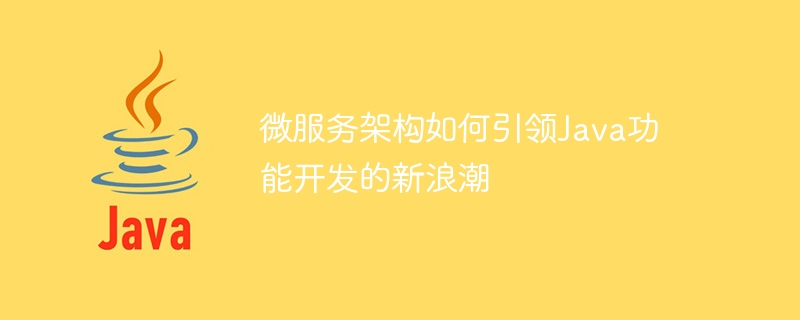

How microservice architecture leads the new wave of Java function development
With the continuous development of Internet technology, more and more companies are beginning to adopt microservice architecture to build Complex software systems. The emergence of microservice architecture has completely changed the traditional single application development model and brought new ideas and methods to Java function development.
1. Advantages of microservice architecture
Microservice architecture takes "each service only does one thing" as the core concept and splits a complete software system into multiple independent Service units, each service unit is responsible for a specific business function. This approach brings the following advantages:
2. The combination of microservice architecture and Java
As an excellent programming language, Java has a wide range of application fields and a rich development ecosystem. In the microservice architecture, Java can play an important role and provide powerful functional development support.
3. Code Example
The following is a simple Java code example of microservice architecture to demonstrate how to implement a user management system:
User-service
@RestController @RequestMapping("/users") public class UserController { // 用户列表 @GetMapping("/") public List getUsers() { // 返回用户列表 } // 新增用户 @PostMapping("/") public User addUser(@RequestBody User user) { // 添加用户并返回新用户信息 } // 更新用户 @PutMapping("/{id}") public User updateUser(@PathVariable("id") long id, @RequestBody User user) { // 更新用户信息并返回更新后的用户信息 } // 删除用户 @DeleteMapping("/{id}") public void deleteUser(@PathVariable("id") long id) { // 删除用户 } }
Order-service
@RestController @RequestMapping("/orders") public class OrderController { // 订单列表 @GetMapping("/") public List getOrders() { // 返回订单列表 } // 新增订单 @PostMapping("/") public Order addOrder(@RequestBody Order order) { // 添加订单并返回新订单信息 } // 更新订单 @PutMapping("/{id}") public Order updateOrder(@PathVariable("id") long id, @RequestBody Order order) { // 更新订单信息并返回更新后的订单信息 } // 删除订单 @DeleteMapping("/{id}") public void deleteOrder(@PathVariable("id") long id) { // 删除订单 } }
Through the above sample code, you can See that each service is an independent Spring MVC controller responsible for specific business functions. Developers can add, update, and delete corresponding resources as needed, and provide corresponding interfaces for other services to call.
Summary:
As a new development model, microservice architecture is leading a new trend in Java function development. It provides a more flexible, stable and scalable system architecture with the advantages of high cohesion, low coupling, independent deployment and expansion. As a programming language widely used in enterprise development, Java can realize efficient, maintainable and highly available software systems with the microservice architecture. Through the demonstration of sample code, we can see the advantages of microservice architecture and the important role of Java in realizing microservices. It is believed that with the continuous development and maturity of technology, the microservice architecture will further promote the innovation and progress of Java function development.
The above is the detailed content of How microservices architecture leads the new wave of Java feature development. For more information, please follow other related articles on the PHP Chinese website!
